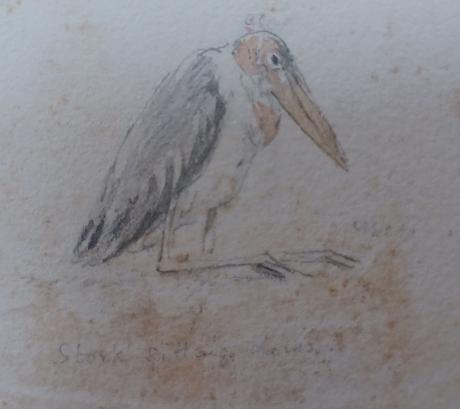Storks are large, long-legged, long-necked wading birds with long, stout bills. They belong to the family Ciconiidae, and make up the order Ciconiiformes Ciconiiformes previously included a number of other families, such as herons and ibises, but those families have been moved to other orders.
Storks dwell in many regions and tend to live in drier habitats than the closely related herons, spoonbills and ibises; they also lack the powder down that those groups use to clean off fish slime. Bill-clattering is an important mode of communication at the nest. Many species are migratory. Most storks eat frogs, fish, insects, earthworms, small birds and small mammals. There are 20 living species of storks in six genera.
Various terms are used to refer to groups of storks, two frequently used ones being a muster of storks and a phalanx of storks.
Storks tend to use soaring, gliding flight, which conserves energy. Soaring requires thermal air currents. Ottomar Anschütz's famous 1884 album of photographs of storks inspired the design of Otto Lilienthal's experimental gliders of the late nineteenth century. Storks are heavy, with wide wingspans: the marabou stork, with a wingspan of 3.2 m (10 ft 6 in) and weight up to 8 kg (18 lb), joins the Andean condor in having the widest wingspan of all living land birds.
Their nests are often very large and may be used for many years. Some nests have been known to grow to over 2 metres (6 ft 7 in) in diameter and about 3 metres (9.8 ft) in depth. All storks were once thought to be monogamous, but this is only partially true. While storks are generally socially monogamous, some species exhibit regular extra-pair breeding.
Popular conceptions of storks' fidelity, serial monogamy, and doting parental care contribute to their prominence in mythology and culture, especially in western folklore as the deliverers of newborn humans.
All 20 stork species have been assessed by the IUCN and carry a confident Red List status. However, the assessment for several species were based on incorrect assumptions and a general absence of sound information on stork habits.
Lionel Grimston Fawkes, grandson of Walter Ramsden Hawkesworth Fawkes (an MP and patron of Turner), began his military training at the Royal Military Academy, Woolwich, he became professor of military topography there... By 1883 he was Dominic Gamble’s aide-de-camp in Jamaica. In 1885 he entered Staff College, Sandhurst. He became a Colonel in the Royal Artillery and later a Justice of the Peace. In 1891 he married Lady Constance Eleanor Kennedy, daughter of a Scottish peer. He was Professor of Military Topography at the Royal Military Academy from 1895 to 1900. By 1923 he and his wife had moved to Canada, purchasing the Point Comfort Hotel on Mayne Island and changing its name to Culzean after Constance’s ancestral home, Culzean Castle. They remained at Culzean for the rest of their lives.
Colonel Fawkes was a very accomplished artist and illustrator. His water-colours are held in collections around the world. Their married daughter, Lois died in 1919 leaving a one year old son Lawrence. Tragedy struck the Fawkes family again in 1921, when their other daughter, Monica, also died. This was all too much for the Colonel and Lady Constance and in 1924 they emigrated to Mayne Island, British Columbia with their son-in-law and grandson.

